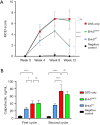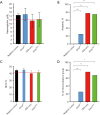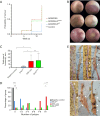Bacillus velezensis inhibits azoxymethane/dextran sulphate sodium induced colitis associated colorectal cancer via the small molecule HeLM
- PMID: 40386616
- PMCID: PMC12078832
- DOI: 10.21037/jgo-24-610
Bacillus velezensis inhibits azoxymethane/dextran sulphate sodium induced colitis associated colorectal cancer via the small molecule HeLM
Abstract
Background: Ulcerative colitis (UC) is a chronic inflammatory condition of the colon. There is a direct correlation between the severity and chronicity of colitis and subsequent risk of colitis associated colorectal cancer (CAC). We have recently shown that a strain of Bacillus velezensis (EHv5) can ameliorate colonic inflammation in the acute setting. This was found to be mediated via the secondary metabolite HeLM and its multifactorial interactions on Toll-like receptors. It is yet to be seen if sustained administration will alleviate colitis over a prolonged period and reduce the risk of CAC. This study will examine the therapeutic potential of EHv5 in ameliorating UC in the chronic setting and assess its ability to prevent CAC.
Methods: CAC was induced in mice (BALB/c) by the administration of intraperitoneal azoxymethane (AOM) and chronic colitis by multiple cycles of dextran sulphate sodium (DSS). Mice were divided into four groups: (I) a negative control; (II) a positive control; (III) the treatment arm receiving EHv5; and (IV) an isogenic mutant of EHv5 that does not produce HeLM, but is otherwise identical. Colitis was assessed throughout the experiment using clinical, biochemical, and endoscopic assessments. A novel scoring system was devised, the chronic colitis associated cancer activity index (CACI) and is compared to the established Disease Activity Index (DAI). Faecal blood and serum haematinics were assessed for iron deficiency anaemia. Tumorigenesis was measured at multiple time points endoscopically and histologically at the end of the experiment.
Results: Compared to the positive control, there was a significant reduction in both the severity and chronicity of colitis in the group receiving EHv5 as measured clinically, endoscopically and with faecal calprotectin. This translated to a significant reduction in both the number and grade of tumours-20% of the group receiving treatment developed tumours of any grade, compared to 80% in the positive control. The CACI score was more reflective to the severity of colitis as the experiment progressed than DAI.
Conclusions: EHv5 provides sustained amelioration of chronic inflammation in a murine model of UC. Strikingly, the effect is such that it significantly reduces the risk of CAC tumour development. This protective effect was not seen in the isogenic mutant, confirming HeLM to be the mechanistic mediator of this beneficial effect.
Keywords: Colitis associated colorectal cancer (CAC); Toll-like receptors (TLRs); azoxymethane/dextran sulphate sodium (AOM/DSS); bacillus; inflammatory bowel disease (IBD).
Copyright © 2025 AME Publishing Company. All rights reserved.
Conflict of interest statement
Conflicts of Interest: All authors have completed the ICMJE uniform disclosure form (available at https://jgo.amegroups.com/article/view/10.21037/jgo-24-610/coif). E.H. reports grant money for his PhD provided by Ashford & St Peter’s NHS Foundation Trust hospital. S.M.C. reports grant from UK Medical Research Council (MRC) under grant No. MR/R026262/1, and he is CEO of SporeGen Ltd. The other authors have no conflicts of interest to declare.
Figures






References
LinkOut - more resources
Full Text Sources
